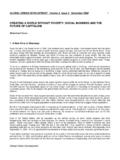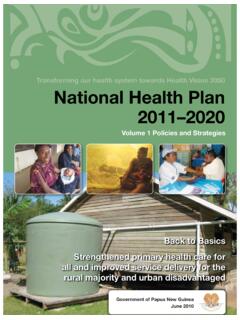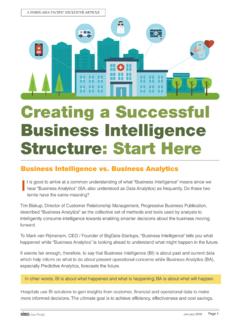Transcription of Healthy workplaces: a model for action - who.int
1 Healthy workplaces: a model for action For employers, workers, policy-makers and practitioners WHO Library Cataloguing-in-Publication Data Healthy workplaces: a model for action : for employ-ers, workers, policymakers and practitioners. health . promotion. - standards. diseases - prevention and control. health Organization. ISBN 978 92 4 159931 3 (NLM classification: WA 440) World health Organization 2010 All rights reserved. Publications of the World health Organization can be obtained from WHO Press, World health Organization, 20 Avenue Appia, 1211 Geneva 27, Switzerland (tel.: +41 22 791 3264; fax: +41 22 791 4857; e-mail: Re-quests for permission to reproduce or translate WHO publications whether for sale or for noncom-mercial distribution should be addressed to WHO Press, at the above address (fax: +41 22 791 4806; e-mail: The designations employed and the presentation of the material in this publication do not imply the ex-pression of any opinion whatsoever on the part of the World health Organization concerning the legal status of any country, territory, city or area or of its authorities, or concerning the delimitation of its fron-tiers or boundaries.))
2 Dotted lines on maps represent approximate border lines for which there may not yet be full agreement. The mention of specific companies or of certain manufacturers products does not imply that they are endorsed or recommended by the World health Or-ganization in preference to others of a similar nature that are not mentioned. Errors and omissions ex-cepted, the names of proprietary products are distin-guished by initial capital letters. All reasonable precautions have been taken by the World health Organization to verify the information contained in this publication. However, the published material is being distributed without warranty of any kind, either expressed or implied.
3 The responsibility for the interpretation and use of the material lies with the reader. In no event shall the World health Or-ganization be liable for damages arising from its use. Printed in Switzerland i | Healthy workplaces: a model for action DESIGN & LAYOUT Philippos Yiannikouris ii | Healthy workplaces: a model for action The wealth of business depends on the health of workers. Dr Maria Neira, Director, Department of Public health and Environment, World health Organization COVER Vertical Job. Photographer: Francisco Monterro, USA. Safe equipment and safe behaviours are both essential to pre-venting occupational risks associated with hazardous tasks(2nd prize in the WHO/Pan American health Organization (PAHO) photo contest 2010, My work, my health ) OVERLEAF Men's job, women's job.
4 Young workers in a pottery workshop in Amman, Jordan, 1993 ILO iii | Healthy workplaces: a model for action Contents .. iv Introduction .. 01 I. Why develop a Healthy workplace initiative? .. 04 II. Definition of a Healthy workplace .. 06 III: Healthy workplace processes and avenues of influence .. 07 IV. The content: avenues of influence for a Healthy workplace .. 09 V. The process: initiating and sustaining a programme .. 15 VI. Underlying principles: keys to success.
5 21 VII. Adapting to local contexts and needs .. 24 References .. 25 Acknowledgements .. 26 iv | Healthy workplaces: a model for action Contents Introduction: a model for action Workers health , safety and well-being are vital concerns to hundreds of millions of working people worldwide. But the issue extends even further beyond individuals and their families. It is of paramount importance to the productivity, competitiveness and sustainability of enterprises, communities, and to national and regional econo-mies. Currently, an estimated two million people die each year as a result of occupational accidents and work-related illnesses or injuries (1).
6 An-other 268 million non-fatal workplace accidents result in an average of three lost workdays per casualty, as well as 160 million new cases of work-related illness each year (2). Additionally, 8% of the global burden of disease from depres-sion is currently attributed to occupational risks (3). These data, collected by the International Labour Organization and the World health Organiza-tion, only reflect the injuries and illnesses that occur in formally registered workplaces. In many countries, most workers are employed infor-mally in factories and businesses where there are no records of work-related injuries or illnesses, let alone any programmes to prevent injuries or illnesses.
7 Addressing this huge burden of disease, economic costs and long-term loss of human resources from unhealthy workplaces is a formi-dable challenge for national governments, eco-nomic sectors, and health policy-makers and practitioners. In 2007 the World health Assembly of the World health Organization endorsed the Work-ers health : global plan of action (GPA) to provide new impetus for action by Member States. This is based upon the 1996 World health Assembly Global strategy for occupational health for all. The 2006 Stresa Declaration on Workers health , the 2006 Promotional framework for occupational health and safety convention (ILO Convention 187) and the 2005 Bangkok charter for health promotion in a globalized world also provide important points of orientation.
8 The Global Plan of action sets out five objec-tives: 1) To devise and implement policy instruments on workers health ; 2) To protect and promote health at the work-place; 3) To promote the performance of, and access to, occupational health services; 4) To provide and communicate evidence for action and practice; 5) To incorporate workers health into other policies. In line with the Global Plan of action , this bro-chure provides a framework for the develop-ment of Healthy workplace initiatives adaptable to diverse countries, workplaces and cultures. 01 | Healthy workplaces: a model for action 02 | Healthy workplaces: a model for action Subsequently, practical guidance specific to sec-tors, enterprises, countries and cultures will be developed by WHO, in collaboration with coun-tries, experts and stakeholders.
9 The principles outlined here are based on a sys-tematic review of Healthy workplace pro-grammes in the global literature, including defini-tions, policies and practices for improving work-place health . The documentation was reviewed at a 22-23 October 2009 Geneva workshop in-volving 56 experts from 22 countries, WHO re-gional offices, related WHO programme repre-sentatives, an ILO representative, two interna-tional NGO representatives, and worker and employer representatives (see acknowledge-ments). The review of this evidence is available in a 2010 background document, Healthy workplaces: a global framework and model : review of literature and practices.
10 It is available online at: OVERLEAF The strength of teamwork . Photographer: Andr s Bernardo L pez Carrasco, Mexico. Workers in a warehouse lift a heavy metal structure in unison to prevent injury (1st prize in the WHO/Pan American health Organization (PAHO) photo contest 2010, My work, my health ) BELOW Humanizing work. Photographer: Marcelo Henrique Silveira, Brazil. A nurse in a Brazilian hospital takes time to read to a patient, offering a moment of mutual enjoyment (3rd prize in the WHO/Pan American health Organization (PAHO) photo contest 2010, My work, my health ) 03 | Healthy workplaces: a model for action I. Why develop a Healthy workplace initiative?
















